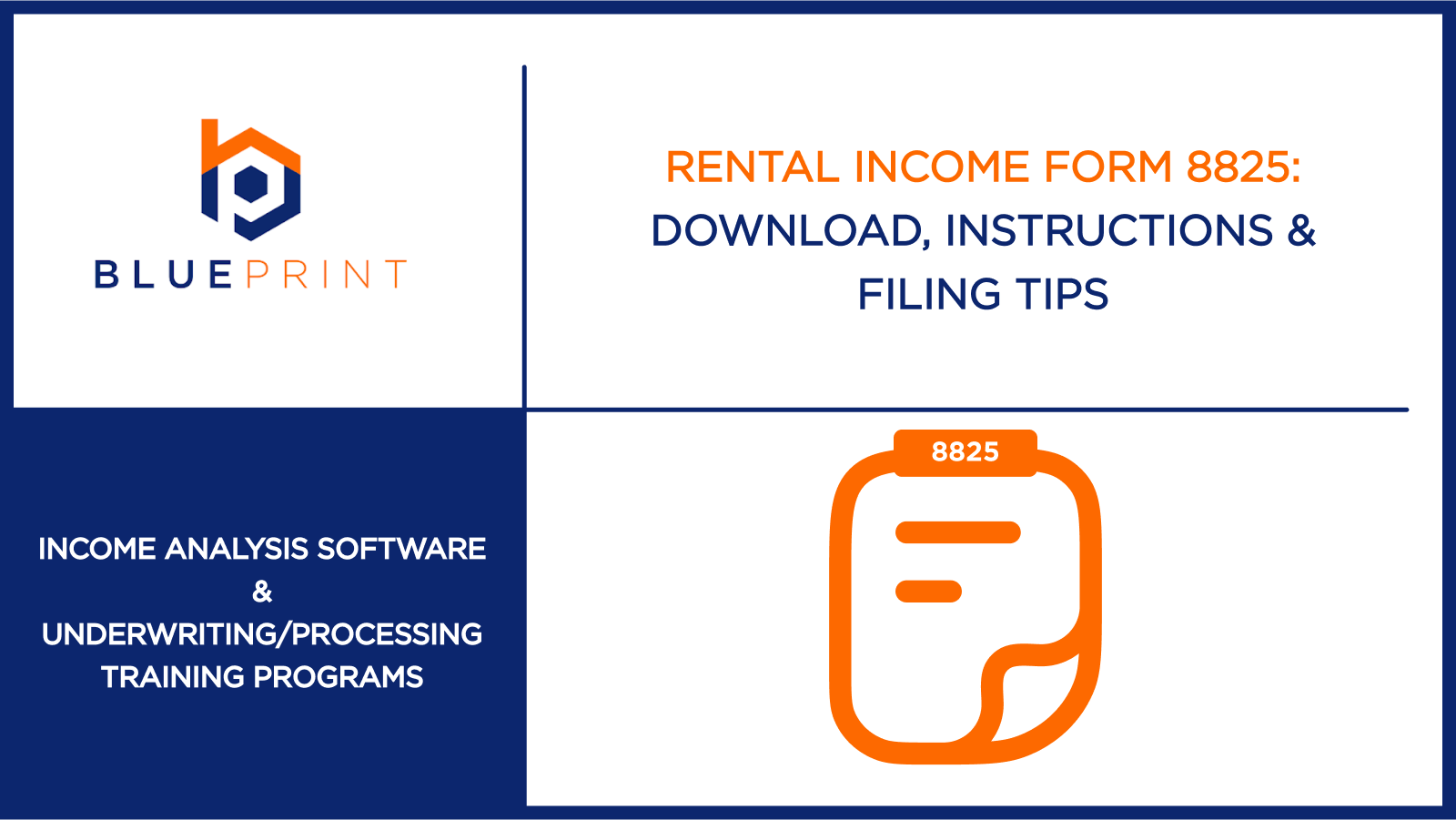If your borrower owns rental property through a partnership or S corporation, IRS Form 8825 is one of the most important documents in the loan file. It outlines income, expenses, and depreciation related to rental real estate, directly affecting debt-to-income ratios, qualifying income, and underwriting decisions.
Yet this form is often misunderstood or filled out incorrectly, which can lead to delays, loan condition requests, or even ineligible applications. Whether you’re a lender reviewing submitted documents or a borrower working with a tax advisor, knowing how Form 8825 works is key to a smooth loan approval process.
In this guide, we’ll break down what Form 8825 is, where to download it, how to fill it out accurately, and the common mistakes that can create problems in the underwriting workflow.
Main takeaways from this article:
- Form 8825 reports rental real estate income and expenses for partnerships and S corporations.
- Accurate reporting on Form 8825 influences mortgage underwriting, particularly for lenders who analyze rental income from business entities.
- Different agencies (Fannie Mae, Freddie Mac, FHA, VA, USDA) treat rental income in slightly different ways—knowing which guidelines apply is key.
- IncomeXpert automates rental income calculations, ensuring compliance and reducing manual errors during underwriting.
Form 8825: Rental real estate income and expenses of a partnership or S corporation
The IRS Form 8825—officially titled Rental Real Estate Income and Expenses of a Partnership or an S Corporation—is used to report rental income and expenses for properties owned by partnerships or S corporations. It parallels Schedule E (which applies to personally owned rental properties) but is tailored to the ownership structure of partnerships or S-corporations. This form must be filed by any partnership or S corporation receiving rental income.
Why this form matters for lenders
Accurate completion of Form 8825 is critical for mortgage underwriting. Lenders use the information on this form to:
- Assess the stability and amount of rental income.
- Evaluate how the reported income or losses impact a borrower’s overall cash flow.
- Determine whether to include or exclude property expenses from the borrower’s debt-to-income ratio.
Because Form 8825 directly affects how much rental income counts toward loan eligibility, any errors can lead to miscalculations of a borrower’s capacity to repay.
How to download Form 8825

You can download IRS Form 8825 directly from the IRS website here. The form is available in a fillable PDF format, which you can complete digitally or print for manual entry.
Other related IRS forms
When filing Form 8825, you may also need to complete:
- Form 1065 (U.S. Return of Partnership Income) for partnerships
- Form 1120-S (U.S. Income Tax Return for an S Corporation) for S corporations
- Form 4562 (Depreciation and Amortization) if claiming depreciation
All of these tax forms are available on this page of the IRS website.
Key considerations for mortgage underwriting with form 8825

Accurately interpreting Form 8825 is essential for underwriting loans tied to rental real estate owned by partnerships or S-corporations. Since agency guidelines vary, underwriters must understand how to evaluate rental income, apply appropriate adjustments, and determine how the property’s income impacts borrower eligibility and debt-to-income ratios.
Understanding agency-specific guidelines
When underwriting loans, lenders must understand how different agencies handle rental income from properties owned by partnerships or S-corporations. Among the five major agencies (Fannie Mae, Freddie Mac, FHA, VA, USDA), four typically include the rental income in the borrower’s K-1 income (or loss) and allow depreciation to be added back to cash flow.
Fannie Mae, however, offers a separate calculation for properties with mortgages in the borrower’s name. If the mortgage appears on the borrower’s credit report, underwriters may offset the property’s PITIA with its net rental income. For positive cash flow, PITIA can be excluded from personal obligations; for negative cash flow, the shortfall must be added to the borrower’s monthly liabilities.
Fannie Mae Selling Guide (B3-3.1-08) states: “If the borrower is personally obligated on the mortgage debt (as evidenced by the inclusion of the related mortgage(s) on the credit report) and gross rents and related expenses are reported through a partnership or S corporation, the business tax returns may be used to offset the property’s PITIA.”
Evaluating net rental income from partnerships and S corporations
Regardless of the agency, the net rental income on Form 8825 is typically the starting point for underwriting. Underwriters analyze:
- Gross rents reported on Form 8825
- Operating expenses and depreciation to determine net income
Partner or shareholder allocation via the K-1 form, which breaks down each owner’s share of profit or loss, including any guaranteed payments
In most cases (except when applying Fannie Mae’s special rules), this net income, plus any depreciation added back, flows into the borrower’s total qualifying income.
Assessing the impact of depreciation and non-recurring expenses
Depreciation, a non-cash expense that reduces taxable income, is typically added back to improve qualifying income. Similarly, large one-time expenses, such as major capital improvements, can distort cash flow and may be excluded if properly documented.
By carefully reviewing Form 8825, underwriters can identify these adjustments and arrive at a more accurate picture of the property’s true income-generating capacity.
Adjusting for PITIA in underwriting calculations
In underwriting calculations, the standard approach (Freddie Mac, FHA, VA, USDA) excludes the property’s PITIA from the borrower’s debt-to-income ratio, as the business typically covers it. Underwriters focus on net rental income after expenses, adding back depreciation when applicable.
Fannie Mae allows lenders to apply the property’s net income against its PITIA if the mortgage is on the borrower’s credit report. For positive cash flow, PITIA can be excluded from personal obligations, while for negative cash flow, the shortfall must be added to the borrower’s monthly debt obligations.
How to evaluate rental income from Form 8825

To accurately evaluate rental income from Form 8825, follow the steps below:
1. Confirm agency guidelines
In order to correctly assess rental income from Form 8825, you must first determine which agency’s underwriting guidelines apply to the loan (Fannie Mae, Freddie Mac, FHA, VA, or USDA). Keep in mind that different agencies have slightly varying rules for incorporating business-owned rental income into the borrower’s qualifying income and debt-to-income (DTI) ratio.
2. For Freddie Mac, FHA, VA, or USDA
If the loan follows Freddie Mac, FHA, VA, or USDA guidelines, use the standard procedure below.
- Verify that the business pays the property’s PITIA: PITIA is typically paid by the partnership or S corporation rather than the individual borrower.
- Exclude PITIA from the borrower’s DTI: Because the business covers these payments, you generally do not include the PITIA in the borrower’s personal monthly obligations.
- Add depreciation back to cash flow: Under Freddie Mac, FHA, VA, or USDA rules, depreciation shown on Form 8825 (and carried onto the business tax returns, typically Form 1065 or 1120-S) can be added back to the borrower’s net rental income for qualification purposes.
Note: If using Fannie Mae, skip this step and proceed to Step 3.
3. Special rule for Fannie Mae loans
Fannie Mae’s guidelines differ when the borrower is personally obligated on the mortgage debt for a property listed on Form 8825. There are two possible scenarios:
Scenario A: No mortgage on the borrower’s credit report
If the property reported on Form 8825 does not appear as a mortgage obligation on the borrower’s credit report, follow the same approach as in Step 2. In other words, exclude the PITIA from the borrower’s DTI and add back depreciation to the net rental income.
Scenario B: Mortgage on the borrower’s credit report
When the borrower’s credit report shows a mortgage for the property on Form 8825, take the following actions for each relevant property:
- Calculate net rental income: Start with the property’s total gross rents. Subtract total expenses as reported on Form 8825. Add back any items that do not represent actual cash outflow, including depreciation, mortgage interest, taxes, insurance, homeowners’ association dues (if applicable), and non-recurring property expenses (if documented).
- Determine monthly cash flow: Divide the result by the number of months the property was in service. Subtract the entire PITIA (for a non-subject property, use the actual PITIA; for a subject property, use the proposed PITIA). This figure represents the monthly property cash flow.
- Adjust the borrower’s obligations based on net cash flow: If the property’s monthly net cash flow is positive, the PITIA can generally be excluded from the borrower’s DTI. If the property’s monthly net cash flow is negative, the shortfall must be added to the borrower’s monthly debt obligations.
To include positive net rental income in the borrower’s qualifying income, verify that it meets Fannie Mae’s requirements for partnership or S corporation income. See Fannie Mae guidelines (B3-3.4-01 and B3-3.4-02) for detailed instructions on analyzing partnership or S corporation returns.
How IncomeXpert helps lenders evaluate Form 8825 for accurate income assessment

Manually interpreting business tax returns and completing Form 8825 can be time-consuming and prone to error. IncomeXpert is designed to simplify this process. Here’s how:
Automates income data extraction from Form 8825
IncomeXpert seamlessly imports rental property data from business tax returns, eliminating the need for tedious manual entry. This automation allows underwriters to focus on analyzing results rather than compiling figures.
Ensures compliance with agency guidelines
The platform stays current with evolving regulations from Fannie Mae, Freddie Mac, FHA, VA, and USDA. It applies the appropriate rule set for each loan scenario, minimizing compliance risks.
Reduces manual errors in income assessment
Built-in validation checks in the platform catch discrepancies and flag missing information before it becomes an issue. Lenders benefit from a more accurate, consistent approach to evaluating partnership and S corporation rental income.
Speeds up underwriting decisions
By streamlining calculations and documentation, IncomeXpert shortens turnaround times for loan approvals. Underwriters can deliver faster decisions without sacrificing precision in cash flow analysis.
Make rental income analysis effortless with IncomeXpert
With the complexities of mortgage underwriting, especially when dealing with rental properties from partnerships or S corporations, having a streamlined solution is key. IncomeXpert is designed to remove the uncertainty of manual calculations, ensuring accurate data for every loan scenario.
IncomeXpert greatly reduces the risk of compliance errors by seamlessly integrating guidelines from all major agencies. Its intuitive interface, combined with robust validation checks, empowers underwriters to deliver faster, more confident decisions. What’s more, this streamlined solution also offers the scalability your business needs.
Ready to experience a transformation in how you handle Form 8825? Request a demo today!
Form 8825 FAQs
What is Form 8825 used for in mortgage underwriting?
Form 8825 reports the rental real estate income and expenses of partnerships and S corporations. Lenders review it to evaluate how much rental income can be used to qualify a borrower for a mortgage.
Who should file Form 8825?
Any partnership or S corporation that owns rental property is generally required to file Form 8825 as part of the entity’s tax return.
What details are required to complete Form 8825?
You must list each rental property’s address, the gross rental income, expenses (e.g., mortgage interest, insurance, taxes, utilities), depreciation, and the resulting net income or loss.
How does Form 8825 differ for partnerships vs. S corporations?
The form remains the same for both entity types, but it is attached to different business tax returns (Form 1065 for partnerships and Form 1120S for S corporations). The K-1 issued to each owner or shareholder shows their share of the income or loss.
Can I use Form 8825 for loans that are not related to rental properties?
No. Form 8825 specifically reports the rental real estate activity of a partnership or S corporation.
What is the difference between Schedule E and 8825?
Schedule E is used by individual taxpayers who personally own and rent out properties. Form 8825 is analogous but is filed by partnerships or S-corporations that own the rental properties.


4 Responses
I love that you guys do this. It would be great if you could also provide a “paid” platform where subscribers could pay a monthly fee to have access to video explanations that provide example documents and example calculations that we could watch and learn from. Just a thought, thank you for the educational info you provide.
Hi Josh
We do offer a paid training service on many UW topics! Email us at info@getblueprint.io for more info!
Mike,
Thanks so much for this. One question—can you still exclude the mortgage payment if you can verify that the payment has been made by the business over the last 12 months.
Hi Michael
In general yes you can deduct the payment if you have evidence of pyament from a business account for 12 months , and looking at the business return you can track down the line that has the expense listed on it. Example if you have a car payment , you may not be able to deduct the pricinpal but you would have interest payments that confirm some type of loan is being paid. That second part is what gets UW in trouble, they see 12 payments from a checking account… but don’t find the matching deducation on the business return.